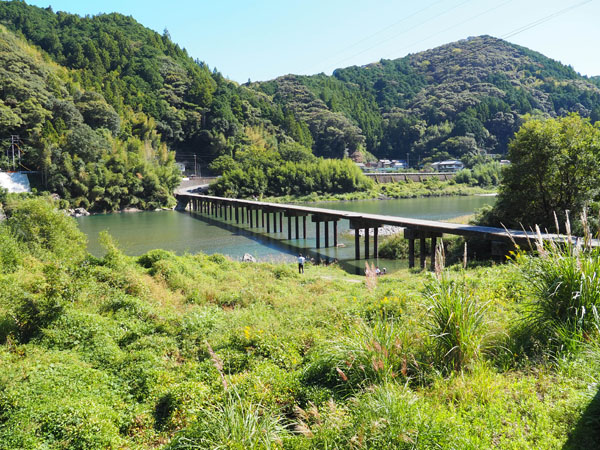Series ”Visiting the village” in search of the key to regional revitalization 5 Hidaka Village Kochi prefecture

Hidaka Village is a village located about 30 minutes by car from Kochi City with a population of 4,800 people and about 1,700 households. It is a production area for Tosa washi paper, and its agricultural focus is on tomato cultivation. Tosa Ninomiya Komura Shrine, said to have been built in 587, and the Nagoshiya Submerged Bridge over the Niyodo River are well-known tourist spots.
Starting in 2021, Hidaka Village will be promoting ”Hidaka Village Entire Digitalization Project”. The project aims to establish smartphones as part of the village’s social infrastructure, improving the lives of villagers and streamlining administrative services.
Mr. Shuso Yasuoka of the Hidaka Village Office Planning Division explains the background behind starting ”Hidaka Village Entire Digitalization Project”.
”Even if we suddenly promote DX of administrative services, how many villagers will be able to use it?If they cannot use the service, it will be no different from the box administration of a long time ago.There is no point in doing so, so first we need to make it possible for villagers to use digital services. We started the business with an emphasis on improving the environment”.
Currently, we are focusing on increasing the penetration rate of smartphones. When we conducted a smartphone penetration survey in the village in May 2020, it was 64.5%. Incidentally, the aging rate is approximately 43%, which is higher than the national average of 28.4%.
When asked why people don’t own a smartphone, the top answers were ”I don’t need it,” ”I don’t know how to use it” and ”It’s expensive”. When such issues come up, it is common to tackle the ones that are easy to solve, but Mr. Yasuoka questions this approach.
”Actually, the issues are complex, and villagers have multiple issues, each with a different priority.For example, even if you solve the issue of high prices, no one will buy something they don’t know how to use, and in the first place, People don’t want to have things they don’t need.That’s why even if you hold a smartphone class, you’ll have a hard time attracting participants.”
From this perspective, we focused on providing multiple and simultaneous support for the issues faced by villagers. Specifically, the purchase cost and running cost of a smartphone will be combined with a health point system. Additionally, we have opened a counseling center and smartphone classes. In addition, he visited more than 50 of the village’s 82 neighborhood associations and explained, including the social background, why smartphones are necessary and what problems would arise if one did not have a smartphone. As a result, villagers’ understanding has improved, and the current penetration rate has increased to nearly 90%.
“Previously, only one in 10 people in their 80s owned a smartphone, but with this initiative, it has dropped to one in three. The digital environment of the entire village has been improved, and the digital divide has been bridged” (Mr. Yasuoka).
Once the penetration rate exceeds 90%, it will become almost a daily necessity, making it easier to apply online using smartphones and digitize administrative services.
In fact, the use of apps within the village is said to be increasing. About 1,200 people, or 25% of the residents, use the health app “Maruken,” which has been available in the village since February of this year. Regarding the fact-finding survey conducted in the village, villagers have begun to request that it be done online instead of on paper.
“The key is confidence. It is important to instill in residents the confidence that they can do it if they try. If residents have that confidence, DX and regional revitalization will progress”, Yasuoka said.
The philosophy of the Hidaka Village Entire Digitalization Project is to use the power of digital to amplify the empowerment of residents.
”During the period of high economic growth and the rapidly increasing population, tax revenue increased and social security was able to be enhanced.In short, a large government with strong public assistance was possible.However, when public assistance became stronger, Even problems that could be solved through mutual assistance and self-help will come to depend on the government.In the future, as the population declines, tax revenues will decline, and the ability of public assistance will decline.Under these circumstances, what is needed is to rebuild mutual assistance and self-help, it is for local residents to solve local issues themselves.We want to create a system where mutual assistance and self-help can be demonstrated through digitalization”, Yasuoka said.
It is true that if everyone leverages the power of digital technology to increase their ability to help each other and self-help, the cost of administrative services will be reduced by that amount, and the work of civil servants will become more efficient. If the surplus energy created in this way can be directed to those who truly need support, the sustainability of the region will increase.
According to the National Institute of Population and Social Security Research, the population of Hidaka Village will be around 2,000 in 2060. That’s less than half of what it is now. We need to start thinking about what kind of village we can maintain even if it reaches 2,000 people.
”In order to maintain villages, the government must promote efficiency and cost reduction, and in order to foster mutual aid and self-help among villagers, we must advance digitalization” ,Yasuoka notes.
